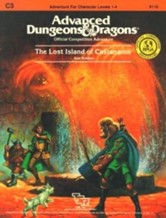 The third module in the Competition series was The Lost Island of Castanamir, a 32-page adventure by Ken Rolston for 5 to 8 characters of levels 1-4. As a competition adventure, it gives guidelines on how to score various teams playing through the adventure. I wonder if they were ever used by anyone who bought the adventure?
The third module in the Competition series was The Lost Island of Castanamir, a 32-page adventure by Ken Rolston for 5 to 8 characters of levels 1-4. As a competition adventure, it gives guidelines on how to score various teams playing through the adventure. I wonder if they were ever used by anyone who bought the adventure?
Ken Rolston is a significant game designer. His work on the game, Paranoia, is influential and well-regarded, and he was the lead designer on both Morrowind and Oblivion, titles in the Elder Scrolls series. The Lost Island dates from his very early days in the industry, and is his first published work for TSR.
It’s also plain weird.
The Lost Island is set in the home of a planar-hopping wizard who went missing a couple of hundred years ago. His island also vanished, but a few years ago it appeared again and a local wizard has hired the party to investigate and loot the place. Unfortunately, they get shipwrecked on the island (and lose most of their supplies). The adventure then concerns them exploring Castanamir’s residence, trying to get enough food to survive, dealing with the monsters, tricks and traps, and looking for the way out.
This is complicated by the wizard having set up his home so that each room so that each door works as a one-way teleporter; going back through the door they just passed through will not lead back to the room they originally came from! The doors are consistent in how they work, so a group can eventually make a map of which door links to which room, but it will likely cause a lot of confusion in the beginning, but eventually the group will be able to map the dungeon.
When you add the contents of the rooms, which tend to the unusual and bizarre, you have the makings of an inventive and enjoyable adventure.
Unfortunately, it doesn’t quite work. The challenges feel very tournament-y, which isn’t all that surprising given its original use. A lot of the challenges are just frustrating for the players, based on logic that is opaque to them. The tone of the adventure is also problematic; the juxtaposition of this strange, dangerous residence with a lot of whimsical or downright silly encounters isn’t something I enjoy. The biggest offender here are the gingwatzim, creatures from the ethereal plane that Castanamir was experimenting with, where quite an interesting concept is undermined by the silly naming conventions Rolston used. There are two pages devoted to these creatures, and their use in the adventure is underwhelming.
I guess if you like frustrating the players with the strange (and humorous) behaviour of unknowable creatures, you’ll enjoy them.
The adventure does have good encounters in it, but I find that a lot of the ideas are good inspiration for the DM but not so good in actual play.
Structurally, the adventure is mostly stand-alone challenges, with two ongoing problems: how do the doors link up, and where is the exit? As once the group exits Castanamir’s residence, there’s no way back (something they don’t know), it reads very much a disposable, one-shot adventure: characters have one chance to get as much loot as they can.
The interior artwork is really good, as Jeff Easley provided a number of smaller and larger works to illustrate the adventure. Several of these illustrations got reused in later hardcover books in the AD&D 1E and 2E lines. The maps, by Diesel, don’t come up so well; they’re adequate but they tend to be quite cluttered.
One thing worth mentioning is the entire adventure, despite being in a 32-page book, feels quite short. Eight pages are devoted to eight pregenerated characters, there are four pages of full-page art, and two more pages detail tournament information. Some of the rooms are very detailed – the library gets over one page.
Ultimately, the biggest problem with the adventure comes down to a mismatch of expectations. Castanamir was an 18th level magic-user, and his dwelling-place is being explored by a group of apprentice adventurers? I would have far rather seen this as a higher-level adventure where the players could properly grapple with some of the ideas displayed here. As it is, it doesn’t really reach the potential of its ideas. It’s a disappointing adventure, although there are a few encounters that can prove enjoyable for the players.

I’ve not looked at it in about 25 years. I wonder how well it could convert to a DCC RPG adventure.
Probably fine, given what I know of DCC (not that much, really!)